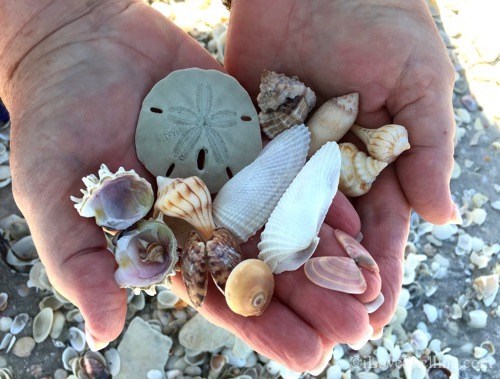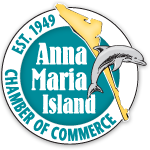Day 3 at your Anna Maria Island vacation rental and it is starting to resemble a seashore in its own right. Bags of moon snails, calico scallops, kittens paw, and banded tulips spill out onto the kitchen table as though they are trying to escape. You even managed to find a few of the elusive sand dollar and even one sea fan skeleton. There are at least two bags dedicated to the coquina shells because your daughter says “they look purply and I want to make necklaces for my friends”.

Planning a trip to Anna Maria Island? Check out our amazing selection of beachfront Anna Maria Rentals and Anna Maria Vacation Rentals right in Anna Maria City!
It is a beautiful day and you have the window open to enjoy the smell of the ocean breeze when something less pleasant catches a ride on the air. After a moment of investigation, you realize that it is the bags of beach bounty that seems to be the source of the offending odor. Hmm, the obvious question, How to clean Seashells?
Have no fear, the pool water is here! I learned this on my first vacation to Anna Maria Island before we moved here. We had so many shells from Bradenton Beach that I think we paid twice the baggage fee on the way home!
If you’d like to rent a property from us near Bradenton Beach – you can find two of the best at South Beach Village # 115 and South Beach Village #111
How to clean Seashells? That same bucket you used to make the epic sand art earlier in the day can come in handy once again. Start by brushing most of the sand out, then rinsing with water to not get sand in the pool. Fill halfway with water from the pool, if you have a vacation rental with a pool, then simply add shells so that they are all completely immersed. Leave overnight and voila most of that ‘not quite the beach smell you like’ is gone!
No pool because you went for direct waterfront rental property? No worries. Some hydrogen peroxide and water from your local Publix at a 10:1 ratio in the same multipurpose bucket will also do the trick.
Fast forward to unpacking the luggage after the flight home. You now have your own personal collection of bubble shells, fighting conch, tritons trumpet, and yes, even lightning whelk. Because, as your son astutely pointed out, you didn’t have those ones yet.
As you sort through your treasures you find some perfect specimens. Alas, more often than not they have a bit of a green tinge and a crusty, leathery outer coating in places. That simply won’t do! You have big decorating plans for those shells. The good news is that there are simple ways to get those shells back to their former luster.
How to Clean Seashells
What You’ll Need:
Time: 5 minutes
Equipment: Bowl or Bucket
Tools: Soft Toothbrush
Cost: $5-$10

The eco friendly ways on How to clean Seashells
1~The miracle of Vinegar! Simple, easy and cheap. Poor a small amount of vinegar into a bowl or cup. Use a soft toothbrush saturated with the vinegar and gently scrub the shell. You may have to do this several times. Then wash with soap and water. Don’t soak in the vinegar though, it will cause a reaction between the acid in the vinegar and the calcium carbonate of the shells. The shells will actually dissolve. It is kind of fun to watch it happen to at least one though:-)
2~ Another cleaning wonder is hydrogen peroxide. Simply put the shells in a bowl and poor enough peroxide to sufficiently cover the shells and let soak for several hours or until a film covers the top. The peroxide has invasive properties making easy work of any bacterial cleanup. Rinse thoroughly and place to dry on a towel.
The not-so eco friendly ways on how to clean seashells
1~ Soak your seashells in a 50/50 solution of bleach and water. The length of time depends on the type of seashells and the number of seashells being cleaned. Just be sure to remove them when the periostracum (that crusty, leathery covering that I mentioned earlier) is gone. I am not a huge fan of bleaching because the shell can absorb the smell. It can also lighten the color. If you try bleaching your shells, try not to leave them in the solution too long.
2~ Without question muriatic acid is the fastest and easiest way to clean your shells. It will almost magically strip the shell of any barnacles or algae and bring the color to back to life! Use only glass jars and plastic tongs due to the caustic reaction with muriatic acid and metals. Wear gloves and eye protection. In your first jar place 3/4 of a cup of water and 1/4 of muriatic acid. Fill the second jar with plain water. Take the plastic tongs and dip in the first jar for about 3-4 seconds then immediately place into the jar with water and place on paper towel or rags to dry. Be careful not to splash any of the liquid onto your skin. It can cause a nasty little burn.
3~You can pick up muriatic acid at a local hardware store or pool supply company. Some states won’t allow you to flush hydrochloric acid unless you neutralize it first. Neutralize hydrochloric acid with baking soda. Wearing your protective garments and working in a ventilated area well away from children, pets, heat and metals, prepare a base mix. Mix 1 lb of baking soda with plenty of water. Slowly add the hydrochloric acid. The mixture will fizz. Add more baking soda until the fizzing stops. This means the hydrochloric acid is neutralized and can now be flushed down the sink with large quantities of water. I have only used this method once. It made me extremely nervous to work with such a strong acid.
Other Methods on how to clean seashells
There seem to be about a million and one ways to clean shells. My neighbor uses ants to remove any decaying material. I have heard that boiling works well. Some sites will tell you to bury them or freeze them. One of my friends puts her shells in the dishwasher. I have not tried any of those yet….. but you never know. If you know of another effective way please let me know by commenting below.
Now that you have a treasure trove of clean shells check our next blog at islandreal.com for suggestions on how to preserve them and some fabulous costal design tips using your new collection! If your wondering what seashells you may have in your collection check out Wikipedia’s page on seashells.

Meet Larry Chatt. Larry is the Broker/Owner of Island Real Estate – and has owned Anna Maria Island investment property while residing in New England, Ohio, Colorado, Iowa and across Europe. He and his family have been on the island for decades and Larry has served his community in various roles with the Anna Maria Island Chamber of Commerce





